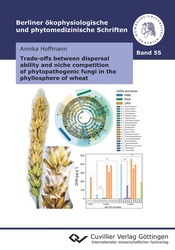| Areas | |
|---|---|
| Serie de libros (96) |
1378
|
| Nachhaltigkeit |
3
|
| Gesundheitswesen |
1
|
| Letra |
2363
|
| Ciencias Naturales |
5406
|
| Matemática | 229 |
| Informática | 319 |
| Física | 980 |
| Química | 1363 |
| Geociencias | 131 |
| Medicina humana | 243 |
| Estomatología | 10 |
| Veterinaria | 108 |
| Farmacia | 147 |
| Biología | 835 |
| Bioquímica, biología molecular, tecnología genética | 121 |
| Biofísica | 25 |
| Nutrición | 45 |
| Agricultura | 1004 |
| Silvicultura | 201 |
| Horticultura | 20 |
| Ecología y conservación de la tierra | 148 |
| Ciencias Ingeniería |
1791
|
| General |
98
|
|
Leitlinien Unfallchirurgie
5. Auflage bestellen |
|
Erweiterte Suche
Trade-offs between dispersal ability and niche competition of phytopathogenic fungi in the phyllosphere of wheat (Volumen 55) (Tienda española)
Annika Hoffmann (Autor)Previo
Lectura de prueba, PDF (620 KB)
Indice, PDF (130 KB)
Unraveling the intricate interplay between plants and microorganisms, this project focuses on the phyllosphere of wheat—a less-explored realm. Investigating Fusarium head blight, a severe threat to wheat crops, the research explores dispersal dynamics, environmental filtration, and temporal dependencies in microorganism interactions. Novel insights into Fusarium dispersal pathways and time-dependent microbial relationships contribute significantly to fungal ecophysiology and agroecology understanding. The findings pave the way for the integration of knowledge into sustainable agricultural practices and predictive models for wheat production.
| ISBN-13 (Impresion) | 9783736979284 |
| ISBN-13 (E-Book) | 9783736969285 |
| Formato | A5 |
| Idioma | Inglés |
| Numero de paginas | 144 |
| Laminacion de la cubierta | mate |
| Edicion | 1. |
| Serie | Berliner ökophysiologische und phytomedizinische Schriften |
| Volumen | 55 |
| Lugar de publicacion | Göttingen |
| Lugar de la disertacion | Berlin |
| Fecha de publicacion | 21.12.2023 |
| Clasificacion simple | Tesis doctoral |
| Area |
Biología
Microbiología y biotécnica Agricultura |
| Palabras claves | Pflanzenmikrobiom, Agrarökosystem, Phyllosphäre, Wurzelbereich, Rhizosphäre, Nutzpflanzen, Weizen, Ährenfusariose, Weizenmikrobiom, fusarium, wheat, species, alternaria, fungal, wind, plant, community, dispersal, mycotoxin, gramiearum, spore, phyllosphere, microbial, control, environmental, pseudomonas, regional, experiment, agricultural, microbiol, inoculation, phytopathogenic, microorganisms, landscapes, diversity, temperatures, cultivation, culmorum, climate, affects, pathogens, disease, characteristics, abudances, deoxydivalenol, fusaria, microbiome, toxins, mechanisms |








